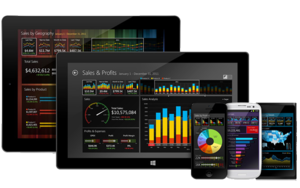Business intelligence is a term that has been widely used, but it generally describes a category of business analytics and diagnostics that relies on “big data” and that is rendered graphically. Until recently, business intelligence has been limited to the enterprise, due to its exorbitant cost and complexity. But with recent developments among SaaS (software as a service, i.e., cloud-based) business intelligence providers, what used to require a small fortune and a team of data scientists is now accessible to the midsize business.
Midsize businesses can now harness the advantages of BI that were traditionally reserved for very large businesses. Following are 4 key benefits now readily available in this new world of SaaS BI. For the purposes of brevity, descriptions of functionality are limited to Microsoft’s Power BI platform.
1. Better Decision-Making with Graphical, Real-time, and Highly Accessible Business Reporting
Business intelligence that is effective, that really “hits the nerve,” has 3 key characteristics. First, it must be graphical. No matter what kind of learner you are (e.g., sensory, auditory, or visual), graphical representations of data seem to have a far greater impact than numbers alone. In our experience, when clients see data represented visually, even data they already had at their fingertips, experience forehead-slapping insights.
Second, it must be real-time. Of course, you can define real-time as you like, whether it be monthly, weekly, or to the minute. Regardless, the ability to adjust on the fly, rather than just learning from your past mistakes, can be the difference between success and failure.
Third, the information must be highly accessible. In other words, to be most effective, it should be the first thing you see when starting your workday, and it should remain readily available, no more than a couple clicks away. Only then can it serve as a pivot point from which the company draws its strategy, its motivation, and its advantage.
Platforms like Microsoft’s Power BI have the critical functionality needed to make business intelligence work. By using these tools to develop an honest view of your business – a graphical, real-time, in-your-face view – companies can be more intelligent in plotting their success. The alternative is untenable. As put by Ken Dixon, Executive VP of Marketing at Kogent Corporation:
"Running a business shouldn't be like gambling. Far too often, executives must rely on 'best guess' and 'gut feel' decisions as they attempt to steer their companies into the future. Business intelligence can provide more accurate historical data, real-time updates, synthesis between departmental data stores, forecasting and trending, and even predictive 'what if?' analysis.”
The all-too-common retrospective, or “post-mortem” view of KPI’s hinders companies’ ability to make timely and strategic changes. Quality BI instead gives decision-makers access to their business data, presented clearly and graphically, in real-time. This eliminates the guesswork involved in making crucial decisions and gives you the answers to business questions when you need them, resulting in an advantage in the marketplace.
Download Now: Best Practices for Data Warehouse Architecture
2. Saved Time and Opportunity Costs
Without sophisticated business intelligence tools, in order to assess the current status of your business, someone in the organization has to find the appropriate data, clean it, interpret it, and determine how to best communicate the resulting information. This is a time-consuming, tedious, repetitive task which is not only undesirable to the employee, but is also an inefficient use of resources, as well as being susceptible to error.
With Microsoft’s Power BI, once data connections are established, those connections persist. As a result, there is no need to regularly mine, interpret, and graph the business data you need on a repetitive basis. Just as the data can be updated automatically, the graphs and visualizations they feed will be updated as well.
Moreover, without the proper tools, the cost of distributing information can be high. For many companies, the dissemination of reports results in significant overhead. Labor costs for the employee tasked with mining data and creating reports, as well as the costs associated with printing and distributing reports on a regular basis can add up quickly. Most significant, time spent by executives and their subordinates searching for data, information, and reports constitutes a significant opportunity cost.
“Today, many business intelligence software vendors are making it possible for users to access key business metrics, reports and dashboards on mobiles devices like their iPhone, iPad, Droid or BlackBerry, giving sales and marketing people access to critical business information on the fly.” – EnterpriseAppsToday, Ten Benefits of Business Intelligence Software
Herein lies the beauty of cloud-based business intelligence. With Microsoft’s Power BI, for example, hosted on SharePoint Online, your business data and reports exist in one secure, central location, where they are accessible to the right people, from anywhere, on any device. The Cloud virtually eliminates the cost of disseminating business information across your organization, as well as making it easier to access at any time.
3. Quickly Identify and Respond to Business Trends and Opportunities
“The next generation of competitive advantage comes from analyzing unstructured content to understand how and why these things happen. From simple content-based metrics to sophisticated sentiment analysis, [business intelligence software can] provide a more complete view on customer and competitor experience and opportunities therein.” – Sid Probstein, CTO, Attivio
Industry trends, consumer buying habits, inventory turnover, and sales/operational parameters are all key sets of data which, when you can measure and keep track of them, will enable you to remain agile in a dynamic business environment.
This is where Power BI shines. Its in-depth analysis and visualizations enable you, in seconds, to see precisely how consumers are behaving, what competitors are doing, and which opportunities your business can capitalize on. As TechRepublic.com put it, “The very nature of the BI toolkit gives rise to a dynamic and readily identified representation of the most pertinent trend data.”
4. Increased Motivation and Teamwork
“Put succinctly, the very nature of strategic BI toolkits will empower managers at all levels to focus on only the most timely and critical data.” – TechRepublic.com

top to bottom, know how their company, industry, and competitors are doing, as well as how their individual performance affects overall organizational performance. Rather than a top-down push to drive activity, good business intelligence will spur the right behavior at every level of the business.
In his seminal book, The Game of Work, Charles Coonradt describes the effect of “keeping score” in an organization (3). With real-world examples, Coonradt illustrates that, just like any game without scorekeeping, a business without effective BI cannot function optimally as a team. While it can be argued that keeping score is micro-managing, the opposite is actually true. On the one hand, when employees know precisely what is expected of them, they tend to thrive. On the other hand, when the “score” isn’t known, employees tend to suffer under a vague and constant pressure to simply do better. And when employees know what the score is, they’re more likely to work as a team; friendly competition emerges as employees spur each other on to improve performance.
Business Intelligence, based in the Cloud, enables all employees to contribute positively to the progress of an organization by increasing visibility into its unique KPI’s. Anyone who has been granted permission can stay up to date on the various trends that matter to the company and to their position specifically, leading to self-motivation and regulation. All of this together helps build a company that is united in vision and action, from the janitor to the CEO.
Conclusion
SaaS business intelligence is arguably the most significant technology advancement for midsize businesses in recent years, and Microsoft Power BI, with its seamless integration with ubiquitous Microsoft tools such as Excel and SharePoint, might be the optimal solution for your company’s strategic needs. Take advantage of this new generation of business intelligence software and get the tools you need to stay ahead of your competition.
Read more about Power BI here.
References:
- Schiff, J. (2010, November 19). Ten Benefits of Business Intelligence Software. - Enterprise Apps Today. Retrieved July 24, 2014, from http://www.enterpriseappstoday.com/business-intelligence/ten-benefits-of-business-intelligence-software-1.html
- Miller, R. (2011, October 12). The benefits of a successful strategic BI implementation. TechRepublic. Retrieved July 24, 2014, from http://www.techrepublic.com/blog/tech-decision-maker/the-benefits-of-a-successful-strategic-bi-implementation/
- Coonradt, C (1984). Game of Work, The: How to Enjoy Work as Much as Play.




